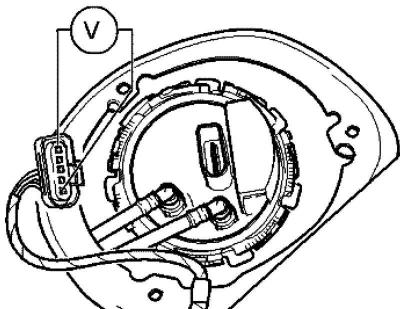Check condition
The fuses must be good.
The battery voltage must be at least 11.5 V.
All electrical consumers, such as headlights and heated rear window, must be switched off.
Function and power check
Remove the back seat.
Remove the fuel delivery module cover.
Turn on the ignition. The fuel pump should audibly start working within 2 seconds.
Switch off the ignition.
If the fuel pump does not turn on, disconnect the 5-pin plug from the fuel delivery module flange.

Pic. 2.339. fuel pump plug
Connect the voltage tester using the auxiliary wires from the Auxiliary Measuring Tool Kit to the external pins of the plug (pic. 2.339).
Switch on the ignition, the LED should be on for about 2 seconds.
Switch off the ignition.
If the LED is off, check the fuel pump relay setting and cables for open or short circuits.
LED on (power supply is OK)
Remove the fuel delivery module.
Check the connection and damage of the electrical cables between the flange and the fuel pump.
No open circuit found
Replace fuel delivery module.
Check the current consumption of the fuel pump
Disconnect the 5-pin plug from the flange of the fuel delivery module.
Set the multimeter to a measurement range of 20 A and connect in series using the auxiliary wires from the auxiliary measuring kit between pins 1 of the plug and the fuel pump.
Note: It is also possible to connect a multimeter clamp meter to the auxiliary wire between pins 1 of the plug and the fuel pump.
Connect pins 5 of the plug and the fuel pump using the auxiliary wire from the auxiliary measuring kit.
Start the engine and leave to idle.
Measure the current consumption of the fuel pump nominal value 7.5 A.
If the measured value is out of specification, replace the fuel delivery module.

Visitor comments